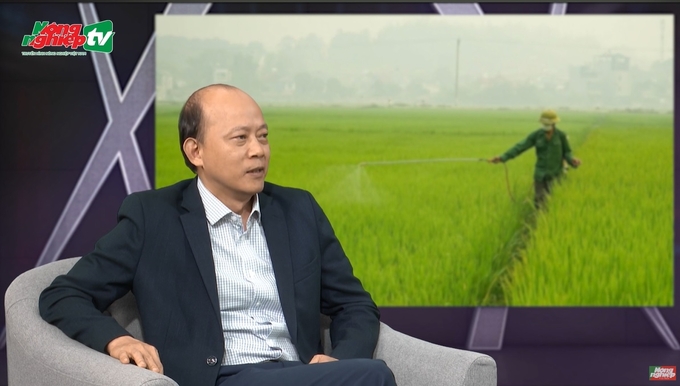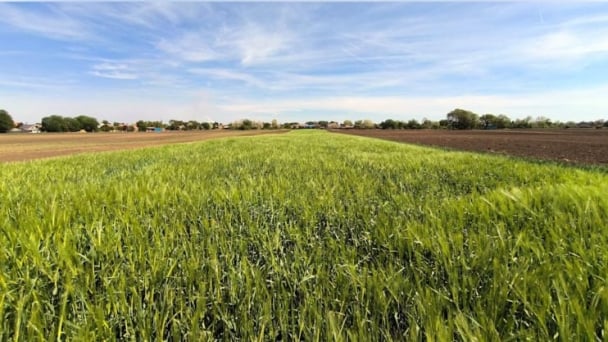June 21, 2025 | 02:55 GMT +7
June 21, 2025 | 02:55 GMT +7
Hotline: 0913.378.918
June 21, 2025 | 02:55 GMT +7
Hotline: 0913.378.918

Dr. Nguyen Huy Chung, Head of Plant Diseases and Plant Immunology Department (Plant Protection Research Institute) in a recent interview with Vietnam Agriculture News.
Neck blast is a very dangerous disease that harms rice and causes heavy losses in many production crops, especially the winter-spring crop in Northern provinces. According to forecasts, soon the weather in the North has a high risk of causing diseases to arise and damage winter-spring rice.
In a recent interview with Vietnam Agriculture News, Dr. Nguyen Huy Chung, Head of Plant Diseases and Plant Immunology Department (Plant Protection Research Institute), shared some solutions and recommendations so that farmers may have better control of the situation.
Dear Dr. Chung, we have information that the Plant Protection Research Institute has implemented research on circulating pathways and modifications of pathogenic fungi that cause rice blasts in our country. Can you share with us how the fungi causing neck blast to modify and how dangerous it is? And along with such movements of the disease, is there anything for the people to take note of?
Mentioning the components of the blast fungi, we all know that during the existing period of the parasite and the host, specifically, rice is the host and the blast fungi are the parasite. And so, during that period there is always competition between both sides. The fungi mutate themselves to create new strains to survive and surpass the resilience of rice varieties.
It’s common knowledge that this story happened in the past. When we just introduced a rice variety to produce, at first its resilience was quite well. After a few years of using that variety, the resilience was gradually lost and weakened. To be more specific, there are some examples I can give such as IR 17494 and IR 1820. These varieties were chosen and bred by the Plant Protection Research Institute, reached the hand of people in the Central region then soon gained their favor. But after a long time, they became infected varieties, but farmers in the Central still love IR 1820 very much. That’s an example.
Recently the Plant Protection Research Institute and Mekong Delta Rice Research Institute have conducted studies on the core components of blast fungi in Vietnam. It can be seen that the number of blast fungus strains is quite large. However, methods of causing disease, conditions for its emergence and development remain fixed. It is still the same, having tight connection to weather conditions, humidity, temperature and also varieties which means hosts with a potential of infection.
As for the recommendation, the first thing, which is the same, is that we have to conduct close inspections. There is no other way. Localities should pay attention to “hot spots” which are areas frequently affected by rice blasts. Due to microclimate conditions, there are areas that are affected almost all year round, even areas and fields if we go into more detail. Therefore, we must have a full understanding of those spots and inspect them regularly to locate the spots of potential disease outbreaks and implement prevention works efficiently.
Secondly, in the long run, perhaps from the way I see it, the MARD as well as the State should further invest in resistant variety breeding and selection works. We have many good varieties at present but their resistance is only to a certain extent. Many varieties possess quality and productivity which gain farmers’ favor but they are easy to suffer a heavy hit from rice blasts. Thus further investment is required to breed and select resistant varieties, using genes with high resistance considering Vietnam’s conditions to put into those varieties or enhance varieties that have good quality and productivity but low resistance so that farmers can have many options when it comes to usage of rice varieties.
Another thing is that a rice variety, before being put to use, must be evaluated on blast resistance. And after a period of use, the author company or state agencies may request re-evaluation because during the production period the variety’s resistance may change due to variation in fungal populations or variety degradation. All those measures, in my personal opinion, may prove to help better rice blast prevention in the long run.
We can see that during this period farmers can’t take this matter lightly. It is clear that the risk of disease emerging and causing damage to a large area is already within sight. So from an expert point of view, we would like to ask Dr. Nguyen Huy Chung: With the characteristics of current weather developments, also considering the risk of neck blast emerging and causing damage, what recommendation on the technical side so that farmers can act soon or detect and treat it in time?
Blast is a very dangerous disease in spring crops, and we know that it has a tight connection to weather conditions, especially humidity and temperature. The spring crop’s condition in the North in general and North Central in particular makes it convenient for the disease to develop and cause damage. For many years we have been taking severe hits due to blast and especially neck blast.
Regarding rice blast, leaf blast might be seen as an easier foe since the signs are recognizable even when conducting inspections. The process of eliminating leaf blast is also an easy feat because when we use fungicide, the later layer of leaves is healed and then replace the lost ones. But neck blast is a hard case. It takes the spores little time to infiltrate and infect the plant in only 3-4 days and the plant will become sick. When farmers see the symptoms clearly, the plant would be incurable. Spraying fungicide no longer holds meaning.
So, as for the recommendations, first, as Mr. Duong has said about strict inspection of rice fields, farmers should check regularly, not now, but even sooner, identifying several risks.
The number one risk is that if they plant disease-infected rice varieties or varieties that once caught the disease, utmost caution is advised. Secondly, areas that are currently affected by leaf blast should receive the same treatment. Thirdly, they must check on weather conditions with absolute attention, because the weather and climate conditions from the pre-blooming to full bloom stage are very sensitive and important.
If we stay close to these three issues, if we don’t spray the entire area, we would only need to deal with the infected varieties and high-risk areas, and closely cooperate with local plant protection agencies. For example, we know that localities have the Sub-department of Crop Production and Plant Protection. There are also agricultural extension stations in the past that are now agricultural service centers. Having keen attention, they are the ones who can give out warnings and prevention methods as well as introduce pesticides recognized by the MARD and Plant Protection Department.
Those are my comments on this matter.
Thank you sir for your sharings!
Translated by Samuel Pham
![Turning wind and rain into action: [9] Digitizing hydrometeorological data in response to climate change](https://t.ex-cdn.com/nongnghiepmoitruong.vn/608w/files/news/2025/06/17/z6704423696987_15fd32ffc26d590d204d520c9dac6786-nongnghiep-165943.jpg)
(VAN) Farmers have begun accessing hydrometeorological applications to adjust their cropping schedules, aiming to ensure productivity and adapt to climate change.
![Turning wind and rain into action: [8] Real-time salinity detection and early warning technology](https://t.ex-cdn.com/nongnghiepmoitruong.vn/608w/files/news/2025/06/17/z6704423696987_15fd32ffc26d590d204d520c9dac6786-nongnghiep-151127.jpg)
(VAN) Thanks to the integration of modern hydrological-hydraulic models, remote sensing technologies, and artificial intelligence, the accuracy of hydrological forecasting has significantly improved.
![Turning wind and rain into action: [7] Early disaster warnings help marine farmers minimize losses](https://t.ex-cdn.com/nongnghiepmoitruong.vn/608w/files/news/2025/06/17/z6704423696987_15fd32ffc26d590d204d520c9dac6786-nongnghiep-142942.jpg)
(VAN) In recent years, thanks to early disaster warnings and forecasting, marine farmers in Khanh Hoa province have been able to reduce risks and losses, thereby improving production efficiency.
![Turning wind and rain into action: [6] ‘Four on-the-spot’ disaster management software](https://t.ex-cdn.com/nongnghiepmoitruong.vn/608w/files/news/2025/06/17/e5a48259d6a262fc3bb3-nongnghiep-183800.jpg)
(VAN) By simply activating the scenario on the disaster management software, the relevant authorities immediately know how many households need to be evacuated, where to evacuate them to, and by what means of transportation…
![Turning wind and rain into action: [5] Hue applies modern technology in disaster forecasting](https://t.ex-cdn.com/nongnghiepmoitruong.vn/608w/files/news/2025/06/17/z6704423696987_15fd32ffc26d590d204d520c9dac6786-nongnghiep-093938.jpg)
(VAN) In Hue city, modern technology has recently been applied in meteorological and hydrological forecasting and warning, helping to reduce the damage caused by natural disasters.

(VAN) A cutting-edge farming technique being implemented on an experimental ranch in Arizona's Sonoran Desert has already saved a billion gallons of water over five years, according to Civil Eats.

(VAN) Poultry and pig production and the environment can be boosted through enhanced water technology, according to new research.